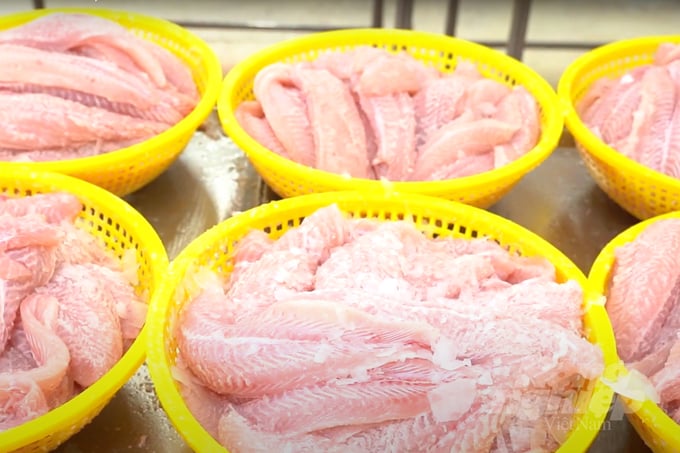May 14, 2025 | 10:05 GMT +7
May 14, 2025 | 10:05 GMT +7
Hotline: 0913.378.918
May 14, 2025 | 10:05 GMT +7
Hotline: 0913.378.918

Shrimp processing for export. Photo: Son Trang.
According to the General Department of Vietnam Customs, in the first 10 months of this year, seafood exports reached US$ 9.4 billion, up 32.7% over the same period last year. Thus, after only 10 months, seafood export has reached 3 critical milestones.
The first is to surpass the record of one-year seafood exports reached in 2021 of US$ 8.9 billion. The second is that seafood exports exceeded US$ 9 billion in a year for the first time. And the third is that the export in 10 months has exceeded the plan for the whole year by US$ 9 billion.
Seafood exports this year grew very impressively, greatly influenced by fluctuations in the world market. High demand for seafood in the first half of this year, combined with global inflation, high energy prices, the Russia-Ukraine conflict, etc., have caused the price of many types of seafood worldwide to increase sharply in general.
In particular, the IUU yellow card that has not been removed is still a challenge. Besides, high inflation, commodity prices, and soaring living costs in the main import markets negatively affected Vietnam's seafood exports.
For example, pollock and cod prices in Europe have hit record highs. According to the United States Department of Agriculture (USDA), in the first nine months of this year, shrimp import prices to the US averaged US$ 9.41 per kilogram, up 8.4% over the same period. Therefore, Vietnam and some of the world's leading seafood-exporting countries will have robust growth in export value in 2022. In 10 months, Norway's seafood exports reached NOK 123 billion (equivalent to US$ 12.4 billion), NOK 27 billion higher than the same period last year and surpassing the export value for the whole of 2021. In October alone, Norway's seafood exports reached NOK 15.4 billion, a record of exports in a month.
Vietnamese seafood also has other significant advantages due to global market fluctuations. The Russia-Ukraine conflict has significantly impacted the global whitefish market as Russia is a leading supplier of many whitefish products (pollock, cod, etc.).
To compensate for the lack of pollock and cod from Russia, many importers have switched to buying some other white fish, including Vietnamese pangasius. As a result, the price of Vietnamese pangasius has increased this year sharply.

The price of frozen pangasius fillets imported from Vietnam into the US increased sharply this year. Photo: Son Trang.
According to USDA, in the 7 months of this year, on average, frozen pangasius imported from Vietnam into the US was priced at US$ 4.21 per kilogram, up 56% over the same period last year.
The high export price is an essential reason for Vietnam's pangasius exports in the first 10 months of this year to reach nearly US$ 2.2 billion, an increase of 80% over the same period in 2021. Mrs. Le Hang, Deputy Director of VASEP.PRO Center forecasts that by the end of this year, pangasius exports can reach over US$ 2.5 billion, up 58% compared to 2021.
In the last months of the year, seafood exports tended to decrease due to the impact of high global inflation on consumers' purchasing power.
According to the Vietnam Association of Seafood Exporters and Producers (VASEP), in October, shrimp exports only reached US$ 313 million, the lowest level since the beginning of the year (except in February with the long Lunar Tet holiday). Pangasius exports in October also fell to the lowest level of the year when it only reached US$ 159 million. However, with the achievement of US$ 9.4 billion in the first 10 months of the year, seafood exports in the rest of the year promise to continue to reach new milestones.
For squid and octopus products, by the end of October 2022, the total export value had reached US$ 625 million, up 32%. It is estimated that in 2022, the squid and octopus exports will reach US$ 734 million, up 22% compared to 2021.
“The Covid-19 epidemic has not ended globally, so it still impacts the demand for squid and octopus. Accordingly, demand still favors squid and octopus products that are reasonably priced, easy to process, have a long shelf life and are suitable for home processing and consumption such as dried squid, dried octopus, etc. frozen octopus…” Mrs. Le Hang said that in 2022, Vietnam's squid and octopus products would be exported to 61 markets, an increase of 2 markets compared to last year.
According to Mrs. Le Hang, it is estimated that Vietnam's seafood exports will reach more than US$ 10 billion by the end of November. This is a historic milestone for Vietnam's seafood industry after more than 20 years of entering the world market.
Translated by Ha Phuc

(VAN) U.S. tariffs are not only a 'shock', but also an opportunity for Vietnamese businesses to renew their mindset toward comprehensive development.

(VAN) As Bac Giang lychee enters the harvest season, Minister Do Duc Duy expects that the fruit will contribute greatly to agricultural exports due to standardized production and deep processing.

(VAN) Consumers have shown a preference for free-range eggs, but those farming systems are more vulnerable to biosecurity risks like bird flu.
/2025/05/09/5701-1-184335_301.jpg)
(VAN) Vietnam’s eel exports nearly doubled thanks to a mud-free farming model, opening up new prospects while still facing numerous barriers related to international standards.

(VAN) Minister Do Duc Duy warned that if production is not professionalized and supply chains are not transparent, the U.S. market could become a growth bottleneck.

(VAN) Delegating surveillance responsibilities to local authorities is a cost-saving and efficiency-boosting measure that removes a key bottleneck for enterprises, according to Director General Duong Tat Thang.

(VAN) Australia's final report on biosecurity has just been released, contributing to expanding the market for Vietnam's fruit with an output of nearly 1 million tons.